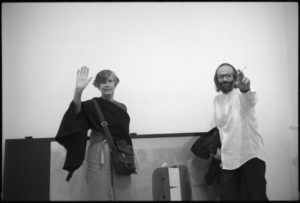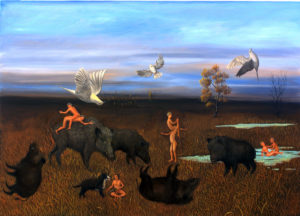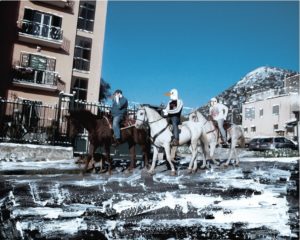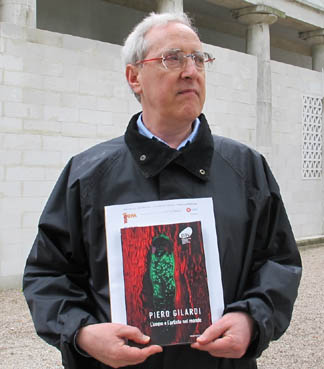Johan & Levi publisher has printed “+ spaces The Toselli galleries” (2019, 680 pages, 75.00 euros) signed by Germano Celant; it is a reasoned and comparative summa between the activity of the Toselli Gallery (from the first opening, in Milan, in via Borgonuovo, in 1967, until the closure of its last gallery, in via Pagano, in 2016) and the international panorama in the background. To say that in this book we find a piece of history of contemporary art is to say not much: here it is possible to find documents, references, comparisons, images that help us to reconstruct a journey of fifty years of activity of a gallery owner who had faith in the contemporary art and at the same time we find a chronology of western art that shows us the analogies and the numerous counterpoints that supported it.
The number of artists who have passed in all these years through its exhibition spaces is truly impressive and the poetics that emerge are linked to an all-encompassing and pervasive climate, but they are also part of a specific singularity, because they do not simply belong to a monolithic furrow, but they are as integral part of a variety of thought that allows us to breathe freely. Franco Toselli has been a great protagonist of the visual culture of the last fifty years and certainly all his work is in good company, compared to the Italian panorama, with other gallery owners like Gian Enzo Sperone, Lucio Amelio, Fabio Sargentini, Giuseppe Morra. Moreover, note of no little account, Toselli has often accompanied his exhibitions with his brief poetic comments, testimonies that have been published not only on the catalogs of the gallery, but also on the pages of the glorious magazine “Domus”, when it was directed by Lisa Licitra Ponti. Among the artists who have passed through the spaces of his galleries, we can remember (in alphabetical order and leaving too many out) the names of: Peter Angermann, Alighiero Boetti, Daniel Buren, Francesco Clemente, Tony Cragg, Gino De Dominicis, Luciano Fabro, Bonomo Faita, Piero Gilardi, Dan Graham, Jan Knap, Joseph Kosuth, Sol LeWitt, Robert Mangold, Mario Merz, Luigi Ontani, A.R.Penck, Paola Pezzi, Emilio Prini, Salvo, Richard Serra, Antonio Serrapica, Antonio Sofianopulo, Lawrence Weiner…
The first question is: dear Franco, how did you manage to put together all these artists?
Dear Roberto, how many are there? This is a true story: the artists saw the gallery as a reference, as an exhibition project. Some of these exhibitions are part of the Toselli legend like those made with Paolini, Fabro, Boetti, Serra, Asher and many others, as can be seen from the book. My gallery was born as a research gallery and on this way it still lives. Many artists, a continuous idea of proposal, not a gallery of representation, but a thought in continuous evolution up to portofranco. Only this is the reason for so many exhibitions and so many artists.
You start in 1967, with your first space in via Borgonuovo: the years were those of an artistic expression in the wake of the dissemination culture that Harald Szeemann, director of Bern Kunstahalle, will validate in 1969, with an exhibition that marked an entire era and was a clear sign of change: When Attitudes Become Form. How did you experience the transition from the years of hard ideology to those of lightness?
At that time I looked very closely at Mario Merz’s work: no ideological harshness but a great energy of a cosmic nature that was diluted in the delicacy of poetry and drawing. His writings are a precious source for me and respond to the true nature of art. Then I wanted to expose the artists of Arte Povera and the American conceptualists of whom I recognized the extraordinary vitality. This expanding energy has occupied the space of my gallery. Objet cache toi is a work by Mario of ‘68, where art coincides with ideology. The thought of art has its nature, it is not me who decides… the angels of Jan Knap were not planned, just as Salvo’s sunsets and Lisa Ponti’s drawings were not foreseen. It was the beginning of the soft revolution, and an exhibition at the Milan Triennale, curated by Elena Pontiggia with portofranco artists in the summer of 2018, was a confirmation.
In this long and fruitful gallery activity is there an exhibition that you regret not being able to do?
I know I did not do a Salvo flower show and I did not conclude a group show dedicated to the donkey and an Anselm Kiefer’s exhibition, with whom I was already talking in the 1980s.
You officially close the gallery business in 2016, but in reality you have never stopped: even now you continue to produce exhibitions with your younger artists. What are the objectives that you are proposing today?
Until you are in the thought of art, work continues. Microbus is the title of an exhibition on fragility: today I think that fragility is a defense. Microbus is the cricket of a story by Jean Cocteau written for Charlie Chaplin; inspired the exhibition with the watercolors of Braghieri and Kazumasa’s small sculptures… only flowers. Someone asked Jean Cocteau what he would save of his house-museum in case of fire, and he replied: “the fire”…
 Mostra di Jo Baer nello spazio di via Melzo, Milano 1974. Foto Giorgio Colombo, courtesy Franco Toselli
Mostra di Jo Baer nello spazio di via Melzo, Milano 1974. Foto Giorgio Colombo, courtesy Franco Toselli
 Emilio Prini e Lisa Ponti nella Galleria Toselli, Milano, inizio degli anni Novanta. Foto Davide Colombo, courtesy Franco Toselli
Emilio Prini e Lisa Ponti nella Galleria Toselli, Milano, inizio degli anni Novanta. Foto Davide Colombo, courtesy Franco Toselli
 Antonio Sofianopulo “Les Jeux des enfants” 2019, olio su tela, cm 80 x 100, courtesy Franco Toselli
Antonio Sofianopulo “Les Jeux des enfants” 2019, olio su tela, cm 80 x 100, courtesy Franco Toselli
 Antonio Serrapica “Vita nevicata” 2007, stampa fotografica dipinta, pezzo unico, courtesy Franco Toselli
Antonio Serrapica “Vita nevicata” 2007, stampa fotografica dipinta, pezzo unico, courtesy Franco Toselli

He is editorial director of Juliet art magazine.






NO COMMENT